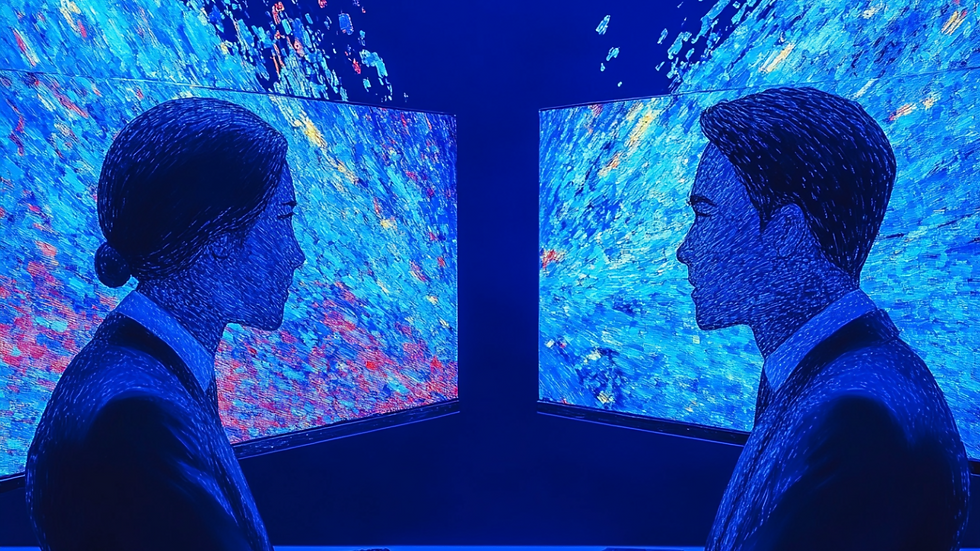When AI-First Backfires: Leadership Lessons from Duolingo’s Misstep
- Hailey Wilson
- Aug 28
- 4 min read
In early 2025, Duolingo — the world’s most popular language-learning app — proudly announced it was becoming an “AI-first company.”
Hundreds of human contractors were replaced by AI-generated content. AI was introduced into employee performance reviews. Leadership signaled that AI-driven experiences would increasingly define the product.
The result? A backlash.
Users quickly noticed a drop in content quality. Employees voiced concerns about job security. Loyal customers criticized the move publicly.
The brand’s playful, human tone — which had driven Duolingo’s marketing success — all but disappeared. Even Duolingo’s TikTok presence went dark for weeks as the company weathered the storm.
Duolingo’s mistake was not adopting AI. It was adopting AI without Emotional Intelligence (EI) — without empathy, ethics, and human-centered thinking.
And this story is far from unique. Across industries, we’re seeing a dangerous pattern emerge: a rush toward AI-first strategies that overlook the human impacts.
The Global Acceleration of AI
AI adoption is happening at an extraordinary speed:
A recent U.S. Chamber of Commerce survey found that 40% of small businesses are now using generative AI — nearly double from the previous year. 91% of those businesses believe AI will drive future growth.
In higher education, 89% of students are already using AI tools such as ChatGPT — but many institutions report that faculty and leadership are unprepared to guide responsible use.
Governments, corporations, and universities are racing to integrate AI across operations — but often without clear frameworks for governance, transparency, or human-centered metrics.
The opportunity is enormous. The risks of getting it wrong are equally profound.
Why “AI-First” Is a Flawed Model
When leaders pursue an “AI-first” approach — prioritizing speed, efficiency, and cost savings — they often overlook how AI impacts their people, their brand, and their trust with customers.
Recent studies across industries reveal three core risks:
AI-first can erode trust.
AI tools, if poorly implemented, can introduce bias, generate inaccurate outputs, or make decisions in opaque ways that damage user trust.
A global survey of corporate AI adoption by PwC found that companies creating sustainable value with AI are those that prioritize transparency, ethics, and governance from the start — not those simply embedding AI into as many processes as possible.
2. AI-first can flatten creativity.
In a large field experiment with over 700 professionals at Procter & Gamble, researchers tested how teams performed when using AI.
They found that teams who used AI as a collaborative partner — combining it with human expertise — consistently outperformed both traditional teams and teams that relied entirely on AI.
The conclusion was clear: AI works best when paired with human creativity and emotional intelligence. Teams that used AI in isolation produced more generic and less innovative outcomes.
3. AI-first can degrade performance when used beyond its strengths.
Another study, involving nearly 800 consultants at Boston Consulting Group, tested AI’s impact across a wide range of knowledge work. The findings? When used for tasks within AI’s capabilities (such as summarization, drafting, and ideation), AI improved speed and quality.
But when used for complex, nuanced, or ambiguous tasks — where human judgment and context are critical — AI degraded outcomes.
In other words, performance suffers without human oversight and emotional intelligence to guide when and how to use AI.
Duolingo’s Mistake, Reframed
Duolingo’s leadership embraced efficiency and scale, but failed to balance these gains with quality, trust, and brand integrity.
They automated too much of what made their product special.
They removed human contributors whose voice and cultural nuance shaped the learning experience.
And they underestimated how AI-generated content, without empathy or ethical consideration, would be received by their loyal customer base.
The result was a brand misalignment — and a very public reminder that AI-first is not the same as good leadership.
What Emotional Intelligence-Led AI Looks Like
The path forward is not to reject AI, but to lead it with emotional intelligence.
A 2025 report from the World Economic Forum, surveying leaders across industries, emphasizes that AI transformation must be part of a responsible, human-centered strategy — not a tech race.
Organizations that do this well:
Build transparent, trust-first AI systems
Design collaborative workflows where AI augments (not replaces) human expertise
Align AI projects with organizational purpose and stakeholder needs
Train their people to use AI with ethics, empathy, and good judgment
How Leaders Can Shift Now
To avoid the pitfalls of AI-first approaches, here are four actions leaders should take:
1. Lead with purpose and values.
AI adoption must align with the organization’s mission and respect its relationship with stakeholders.
2. Invest in AI literacy through an ethical lens.
AI training should include not just tools, but critical thinking, ethical use, and human-AI collaboration.
3. Design workflows that pair AI with human expertise.
AI should augment human intelligence, not replace it. Teams that balance AI with creativity, context, and emotional intelligence produce far better outcomes.
4. Measure what matters.
Success metrics should include not just efficiency, but also trust, employee engagement, and customer experience.
The Path Forward
AI will define the next era of business and society. But those who pursue AI-first at the expense of EI will repeat the mistakes we’re already seeing:
Loss of trust
Damage to brand reputation
Erosion of employee and customer loyalty
The future belongs to leaders who understand: Powerful AI must be guided by powerful EI.



Comments